Simple Summary
Auto contouring driven by artificial intelligence can improve the workflow of radiotherapy by accelerating the contouring process. However, quality assurance of artificial intelligence-based tools is necessary for ensuring safety and efficacy in a clinical practice. In this study investigated the geometric accuracy of structural contours created by a commercial software for autocontouring based on artificial intelligence using well established metrics. In particular, the impact on the radiotherapy treatment plan quality from the adoption of artificial intelligence generated contours was investigated. Our results show that the combination of automatically generated contours and careful review by a clinical radiation oncologist results in time saving without affecting the quality of treatment plan. In conclusion, after quality checks that involve both geometric accuracy as well as dosimetric impact, contouring based on AI can be safely adopted in clinical practice.
Abstract
Purpose: When autocontouring based on artificial intelligence (AI) is used in the radiotherapy (RT) workflow, the contours are reviewed and eventually adjusted by a radiation oncologist before an RT treatment plan is generated, with the purpose of improving dosimetry and reducing both interobserver variability and time for contouring. The purpose of this study was to evaluate the results of application of a commercial AI-based autocontouring for RT, assessing both geometric accuracies and the influence on optimized dose from automatically generated contours after review by human operator. Materials and Methods: A commercial autocontouring system was applied to a retrospective database of 40 patients, of which 20 were treated with radiotherapy for prostate cancer (PCa) and 20 for head and neck cancer (HNC). Contours resulting from AI were compared against AI contours reviewed by human operator and human-only contours using Dice similarity coefficient (DSC), Hausdorff distance (HD), and relative volume difference (RVD). Dosimetric indices such as Dmean, D0.03cc, and normalized plan quality metrics were used to compare dose distributions from RT plans generated from structure sets contoured by humans assisted by AI against plans from manual contours. The reduction in contouring time obtained by using automated tools was also assessed. A Wilcoxon rank sum test was computed to assess the significance of differences. Interobserver variability of the comparison of manual vs. AI-assisted contours was also assessed among two radiation oncologists for PCa. Results: For PCa, AI-assisted segmentation showed good agreement with expert radiation oncologist structures with average DSC among patients ≥ 0.7 for all structures, and minimal radiation oncology adjustment of structures (DSC of adjusted versus AI structures ≥ 0.91). For HNC, results of comparison between manual and AI contouring varied considerably e.g., 0.77 for oral cavity and 0.11–0.13 for brachial plexus, but again, adjustment was generally minimal (DSC of adjusted against AI contours 0.97 for oral cavity, 0.92–0.93 for brachial plexus). The difference in dose for the target and organs at risk were not statistically significant between human and AI-assisted, with the only exceptions of D0.03cc to the anal canal and Dmean to the brachial plexus. The observed average differences in plan quality for PCa and HNC cases were 8% and 6.7%, respectively. The dose parameter changes due to interobserver variability in PCa were small, with the exception of the anal canal, where large dose variations were observed. The reduction in time required for contouring was 72% for PCa and 84% for HNC. Conclusions: When an autocontouring system is used in combination with human review, the time of the RT workflow is significantly reduced without affecting dose distribution and plan quality.
1. Introduction
Radiation therapy (RT) is considered as an alternative to surgery for early-stage cancer, whereas locally advanced cancer is mostly treated in conjunction with surgery and systemic radiation therapies according to patient’s age and comorbidities [1,2,3]. Improper delineation of the target volume and organs at risk (OARs) can affect the quality of dose distribution designed during planning of the RT treatment. As a consequence, inadequate target coverage or normal tissue sparing may occur, resulting in a reduced tumor control or an increased probability of side effects [4]. Traditionally, tumor volumes and OARs are manually contoured by radiation oncologists. This is a laborious procedure that is subject to both intra- and interobserver variability [5]. In this scenario, automatic contouring methods can minimize the clinical workload as well as improving reproducibility of RT. In the contouring workflow, the automatic contours depict a starting point, which is reviewed and, if necessary, manually edited before being sent to the treatment planning system.
Atlas-based contouring [6], statistical models of shape and appearance [7], artificial intelligence-based methods [8], and hybrid strategies are a few examples of the automated contouring techniques that have been introduced and developed with promising outcomes. The spread of artificial intelligence (AI) is impacting the workflow of RT treatment in several scenarios [9], and AI-based autocontouring software has been developed and made available to oncologists to optimize the contouring process [10]. A question that arises is whether the automated contours are of sufficient quality for clinical use, which can be answered only after effective validation, that is, evaluation of accuracy and reliability. The existing literature indicates that contour evaluation is performed mostly at the geometric level [11,12,13] using common geometric metrics, including moment-based methods, overlap metrics, and distance-based measures [14]. However, geometrical metrics alone do not necessarily reflect the actual clinical impact of the contour differences [11,12,13]. Treatment dosimetry, plan quality, and associated clinical decision-making processes are directly influenced by accuracy of contoured regions, and the impact of the geometric agreement into the dose domain and plan quality remains to be fully investigated [14,15,16,17].
Research Objectives
With the capability of automatically providing contours that can be used to generate clinically acceptable plans, commercial tools for automated segmentation can reduce treatment planning time substantially. The objective of this study was to investigate the accuracy of structure contours generated by commercial autocontouring software. Also, we wanted to investigate the dose distributions of the treatment plans generated from autocontoured structure sets.
2. Materials and Methods
2.1. Patient Data
After approval from the institutional review board of Centro di Riferimento Oncologico (CRO), 40 patients treated at CRO Aviano from September 2017 to June 2022 were selected retrospectively for this study. A total of 20 had been treated for prostate cancer (PCa) and 20 for head and neck cancer (HNC). The PCa patients’ preparation before CT acquisition included full bladder and empty rectum. Patients with bilateral hip implants or rectal spacer were not included in the study. Patients with HNC cancer required no preparation but were immobilized with a thermoplastic mask. No contrast was administered for any patient before CT image acquisitions.
Patients CTs for planning of the treatment were acquired using a 90 cm wide bore Toshiba Aquilion 16 CT simulator with 5 mm slice thickness for PCa and 2 mm for HNC. Images were reconstructed using FC13 reconstruction algorithm having a 256 × 256 matrix.
2.2. Contouring Workflows
Target volume delineations are ruled by international guidelines and scientific associations recommendations. The contoured structures for PCa patients included the entire prostate and its capsule, which represent the clinical target volume (CTV) as well as the organs at risk. The planning target volume (PTV) was created by expanding CTV by 5 mm margin in all directions except 3 mm posterior. For HNC, organs at risk were contoured automatically, while the CTV was not automatically contoured.
Contoured structures, excluding the PTV, were generated for each patient using three methods, as follows:
- -
- Manual contouring (Cman). Contours were delineated by a radiation oncologist with at least ten years of experience, also using semiautomated tools like flood fill and interpolation, within the integrated ARIA and Eclipse TPS systems (version: 16.1; Varian Medical Systems, Inc., NewYork, CA, USA) [18] and following the institutional guidelines [19,20,21]. These contours were assumed as the ground truth structures.
- -
- Fully automated contouring based on artificial intelligence (CAI). These were automatically created using a research version of Limbus Contour (version: 1.0.18; Limbus AI Inc., Regina, SK, Canada) [22] software. Limbus Contour (LC) employs organ-specific deep convolutional neural network models on the basis of a U-net architecture [23], which were trained on CT images from the Cancer Imaging Archive public database [24]. Following the creation of contours, LC applies a number of postprocessing techniques including as outlier removal, slice interpolation, z-plane cutoffs, and contour smoothing [23]. Contouring the structure set on a patient required up to 7 min on 3.2 GHz Intel Pentium CPU G3420; 4 GB RAM; 64-bit Operating System. The Limbus-generated RT structure sets were exported as DICOM files into the Varian Eclipse workstation for revision and validation.
- -
- automatically generated contours reviewed and eventually adjusted by radiation oncologist (CAI,adj). Expert ROs reviewed and, if necessary, modified the CAI using the Eclipse contouring application in accordance with institutional consensus guidelines for target volume and OAR contours. In order to keep ROs blinded to the original contours’ creation, only CAI contours were visible to them during revision time.
For better reproducibility, manual contouring was performed by one radiation oncologist for each treated site and interobserver variability was measured between two operators for PCa (Section 2.9).
2.3. Treatment Planning and Delivery
The radiotherapy plans that had been previously delivered to the patients were assumed as the reference for dose comparison. Structure sets for these treatments were manually contoured by radiation oncologists (ROs) using the institutional protocol for Radiotherapy Oncology Group. Treatment planning was performed using dose prescription and constraints for planning shown in Table 1 and Table 2.

Table 1.
Dose constraints used for planning of PCa treatment.

Table 2.
Dose constraints used for planning of HNC treatment.
PCa treatments were delivered using the volumetric modulated arc therapy (VMAT) technique with one or two 18 MV full coplanar arcs, 600 MU/min maximum dose rate, and a prescribed dose of 60 Gy in 20 fractions each of 3 Gy. HNC patients received intensity-modulated radiation therapy (IMRT) treatments with nine 6 MV photon beam fields, a maximum dose rate of 300 monitor units (MU) per minute, and a prescribed dose of 70.95 Gy in 33 fractions of 2.15 Gy each. These plans were generated using the Eclipse planning system (Varian Medical). Dose calculations were performed using the anisotropic analytical algorithm (AAA) with a grid resolution of 2.5 mm [25]. The treatment schedule consisted of 5 daily fractions per week. The treatments were administered using a Varian TrueBeam or Trilogy linear accelerator. A cone-beam computed tomography image was acquired at the beginning of each treatment session for image-guided RT [26]. For evaluation of dose difference due to autocontouring in the planning workflow, treatment plans were exactly same for the structure set CAI,adj following the same planning and optimization procedure as for the plans clinically used. Plans were exported for analysis in RT DICOM formats from the treatment planning system. DICOM files were transferred to a high-performance computer interface for analysis with homemade MATLAB scripts.
2.4. Qualitative Assessment of Automated Contouring
An experienced clinician assessed the CAI for each patient using a four-point Likert scale, shown in Table 3, to evaluate qualitatively the automated contouring process. As such a test aims at distinguishing between AI and human operator, this is sometimes referred to as the Turing test [27,28].

Table 3.
Scoring values for qualitative assessment of AI-generated contours.
2.5. Geometric Evaluation
For target and OAR structures, comparisons between Cman and CAI contours before and after the physician review (CAI,adj) were compared with these metrics described herein. For comparing AI- versus human-generated contours, we used different types of geometrical metrics that are based on distance between surfaces, size of overlapping volumes, and difference in size [29].
Dice similarity coefficient (DSC) provides a measure of the volumetric overlap of two contours of a structure with a score range from 0 (no overlay) to 1 (total overlay) [30]:
Hausdorff distance (HD) is a bidirectional measure of distance between contour surfaces [30]. This metric calculates the distance to the closest point in both directions, from contour Cman to contour CAI,adj and vice versa, to figure out the largest surface-to-surface separation between two contours.
where h (,) represents the Euclidean distance between a and b voxels corresponding to the Cman and CAI/CAI,adj contours, respectively, and the formula is:
Relative volume difference (RVD), also known as relative absolute volume difference, describes the size difference between the regions:
where Vman and VAI,adj represents the absolute volume corresponding to the Cman and CAI,adj contours, respectively.
2.6. Evaluation of Dose Differences
To assess the potential impact of AI on dosimetry, we calculated the difference in dose indexes among plans as:
where (DX)man and (DX)Ai,adj referred to dose parameters for Cman and CAI,adj contours, respectively. And X represents the dose metrics such as Dmin, Dmean, and D0.03cc.
Dose distribution to the organs-at-risk (OAR) doses were evaluated using Dmean (mean dose) and the highest dose encompassing 0.03cc, D0.03cc [31].
Homogeneity Index (HI) was utilized to evaluate the dose uniformity within the PTV. HI was assessed using the following formula [32]:
Where D2% (near maximum dose), D98% (near minimum dose), and D50% represent the minimum dose covering 2%, 98%, and 50% of the target volume, respectively. Formula for HI comparison between plans for Cman and CAI,adj contours was-
where HIman and HIAI,adj represent the HI for Cman and CAI,adj contours, respectively.
Conformity Index (CI) was used to obtain a quantitative evaluation of the PTV coverage by the prescribed dose. CI was evaluated using the following equation [33]:
where VTV indicates the volume that receives 95% of the prescribed dose, VPTV represents the PTV volume, and TVPV is the PTV volume inside the VTV. CI comparison between Cman and CAI,adj contours plan was carried out by using the formula below:
where CIman and CIAI,adj indicates the Cman and CAI,adj contours CI, respectively.
2.7. Normalized Plan Quality Metric
The plan quality metric (PQM) framework was designed to establish a standardized approach for assessing how well a particular treatment plan achieves specific dose volume objectives that serve as a hypothetical “virtual physician” [34]. A PQM scorecard is often created for every objective which assigns a score based on how effectively the objective is achieved by a particular plan. To enable meaningful comparisons across our study cases, we utilized the normalized PQM (nPQM) score, which divides the PQM score by the peak score achievable by the plan of a certain district (PQMmax) and scales to the percentage. The formula used for the normalized plan quality metric was:
The PQM scorecard to be used for analysis in this trial is shown in Table 4 and Table 5. To calculate the score for a particular objective, there are two different types of functions: threshold and linear score. The threshold score’s function awards no points if the objective is not achieved and the maximum number of points for the accomplished objective. The linear score’s function makes use of two thresholds. Maximum points are awarded if the plan satisfies the constraint’s “ideal threshold” and no points are assigned if it does not exceed the constraint’s “minimally acceptable threshold”. Using the value of the dose-volume statistic, linear interpolation between the two thresholds is used to calculate the number of scores awarded if the objective is between the two thresholds.

Table 4.
PQM of PCa treatment plans.

Table 5.
PQM of HNC treatment plans.
2.8. Evaluation of Contouring Time
The amount of time required for contouring was measured in order to estimate the increase in performance made possible with autocontouring. Since in clinical practice AI-generated contours need always to be reviewed and eventually modified by a radiation oncologist, we measured the reduction in contouring time from autocontouring as
2.9. Interobserver Variability
The interobserver variability was assessed by comparing autogenerated structures reviewed and adjusted by two different operators. The geometric differences were calculated by assessing DSC, HD, and RVD among AI-assisted contours performed by the two operators:
where is the contour generated by AI and adjusted by operator 1.
Dosimetric evaluation was performed using the same methods previously described. For instance, the interobserver variability for Dmin to an organ at risk was calculated as
where and are the minimum doses to an organ at risk generated using AI and adjusted by operators 1 and 2, respectively.
2.10. Data Analysis
For geometrical and dosimetric evaluation, we developed an in-house script in MATLAB version R2021a (The MathWorks, Inc, Boston, MA, USA) [35] to compare structure sets and treatment plans for both the automatic and the manually edited contours as shown in Figure 1. Wilcoxon rank sum test was employed to perform dosimetric comparisons to determine if there were any significant differences between the individual OARs in each arm in terms of the Dmin, Dmean, and D0.03cc doses based on the reference dose distribution, and significant differences for the PTV doses in terms of HI and CI were assessed with the alpha (α) value 0.05 for 95% CI.
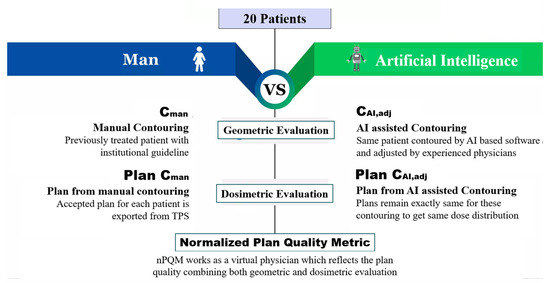
Figure 1.
Comparison procedures for contouring evaluation.
3. Results
3.1. Qualitative Assessment of Automated Contouring
Results of the quality assessment for the PCa and HNC contours are shown in Figure 2 and Figure 3, respectively.
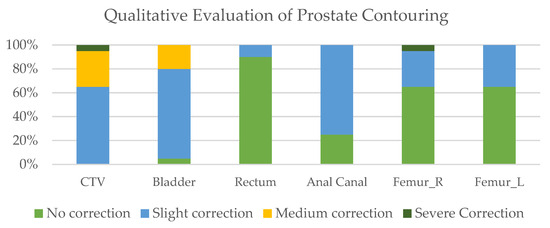
Figure 2.
Evaluation of AI-based contouring for PCa.
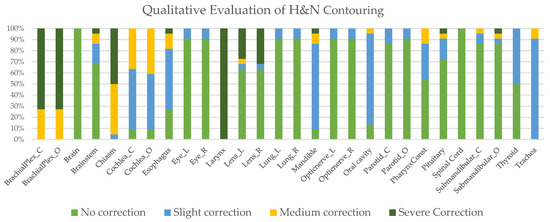
Figure 3.
Physician assessment of AI-based contouring for HNC.
3.2. Geometric Comparison
Table 6 and Table 7 show the differences among structures contoured with different modalities. The highest average DSC values were observed for the bladder and rectum, followed by the anal canal and prostate. The values of the average HD were 4.19 mm, 2.85 mm, and 1.08 mm for prostate, bladder, and rectum, respectively. The values of the RVD showed the same trend: 0.08, 0.02, 0.01 for prostate, bladder, and rectum, respectively.

Table 6.
Summary of DSC, HD, and RVD values measured before and after physician contours, (CAI vs. CAI,adj) for PCa cases.

Table 7.
Summary of geometric difference metrics measured between Cman and CAI,adj contours measured with different metrics for PCa cases.
Figure 4 shows DSC, HD, and RVD scores for PCa cases. For PCa, large variabilities in terms of DSC and RVD were observed for anal canal and both femur heads in comparison between Cman and CAI,adj contouring. As for HD values, a wide range of values was reported for femur heads.
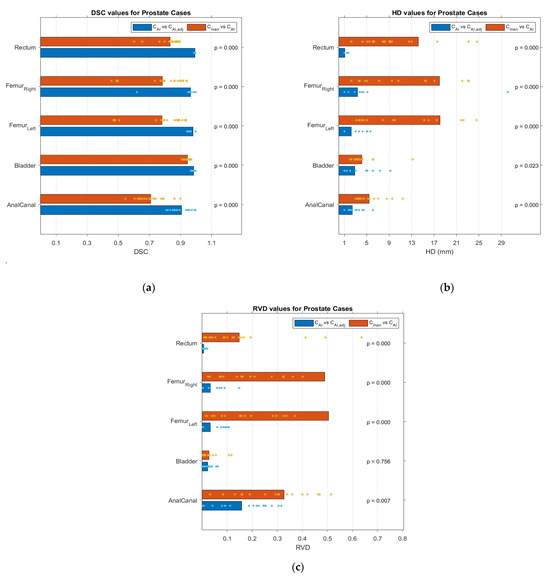
Figure 4.
Geometric evaluation results: (a) DSC, (b) HD in mm, and (c) RVD, for CAI,adj contours in comparison with both CAI and Cman contours of PCa cases. Each * represents a value.
Table 8 provides a complete list of DSC, HD, and RVD values for HNC contours. The brain, mandible, parotids, and thyroid showed a high level of correlation with average DSC scores of 1.00, 0.98, 0.99, and 0.94, and average HD scores of 0.65 mm, 8.13 mm, 1.50 mm, and 9.58 mm, respectively, between the contours of before (CAI) and after physician review (CAI,adj). RVD values were generally close to 0.

Table 8.
Summary of DSC, HD, and RVD values measured before and after physician contours (CAI vs. CAI,adj) for HNC cases.
Figure 5 shows the geometric evaluation results of CAI contour and Cman contour both compared with CAI,adj contours. Autocontouring resulted in similar results for the brain, brainstem, mandible, and eyes (DSC > 0.83). For the brachial plexuses, parotids, cochlea and submandibular glands, there was a significant difference between the Cman contour and CAI,adj contour, while other OARs had better performance in terms of DSC, HD, and RVD.
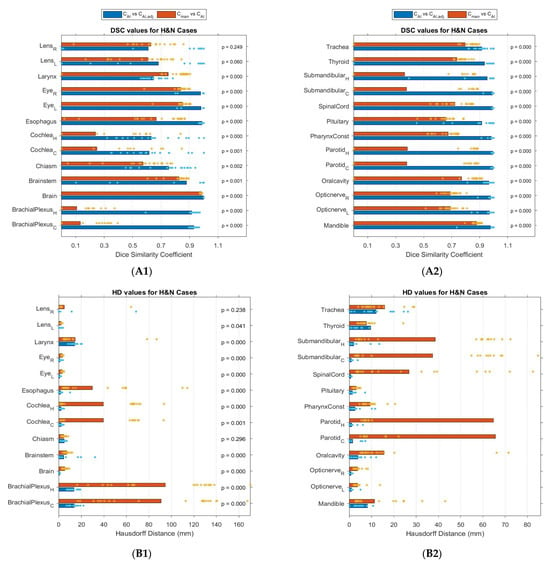
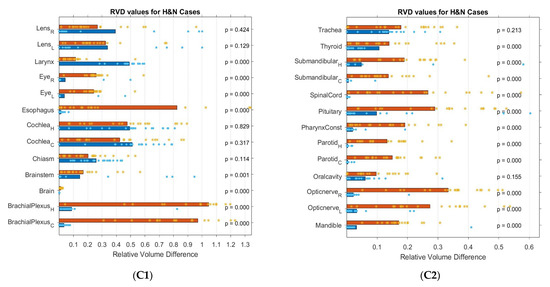
Figure 5.
Geometric evaluation results: (A1,A2) DSC, (B1,B2) HD in mm, and (C1,C2) RVD, for CAI,adj contours in comparison with both CAI and Cman contour of HNC cases. Each * represents a value.
Table 9 summarizes the DSC, HD, and RVD values calculated between the Cman and CAI,adj contours. The worst metrics were found in smaller structures such as lenses, while larger structures including the brain, mandible, eyes, and trachea showed a high level of correlation, with average DSC around 80% and lower HD and RVD values.

Table 9.
Summary of geometric difference metrics measured between Cman and CAI,adj contours measured with different metrics for HNC cases.
3.3. PTV Evaluation
Figure 6 shows the geometric and dosimetric comparison of the Cman plan compared with CAI,adj for prostate PTV in terms of DSC and RVD scores and differences in HI and CI.
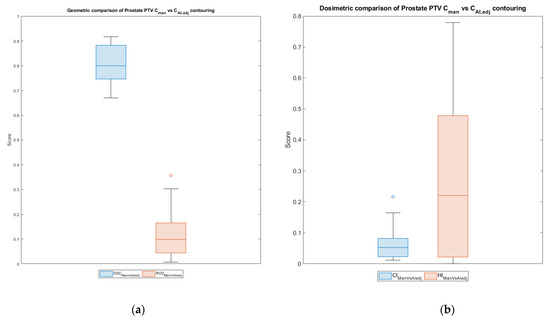
Figure 6.
(a) Geometric evaluation by DSC and RVD and (b) dosimetric evaluation in terms of homogeneity index and conformity index of prostate PTV. Each circle symbol represents a value outside the standard deviation. Each circle symbol represents a value outside the standard deviation.
3.4. Dosimetric Comparison
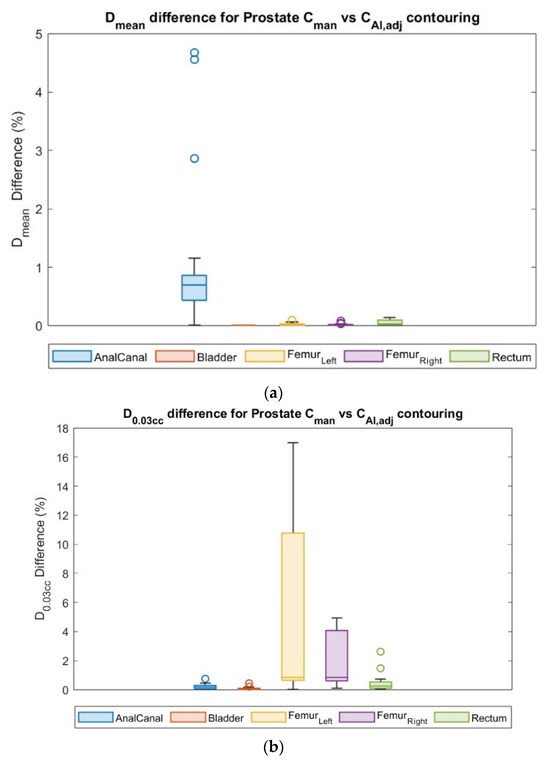
Figure 7.
Dosimetric evaluation results: (a) relative difference in mean dose (Dmean), and (b) relative difference in dose of 0.03cc volume (D0.03cc), for plan form Cman contour in comparison with CAI,adj contours of PCa cases. Each circle symbol represents a value outside the standard deviation.
The quantitative results of the dosimetric comparisons of plans with the Cman plan compared with CAI,adj contours are summarized in Table 10. No significant dose differences were measured between manual and autocontour workflows, except the anal canal for PCa cases.

Table 10.
Relative differences in Dmean and D0.03cc values measured between Cman and CAI,adj contours for PCa cases.
Differences in Dmean to OARs for HNC between Cman and CAI,adj contours are shown in Figure 8a, where the esophagus exhibited relatively large variations in ∆Dmean. D0.03cc to the eyes and cochleas had a difference of a maximum of 13% between the Cman and CAI,adj plans (Figure 8b), while other OARs showed <10% differences, except for the constraint of contralateral brachial plexus and brainstem. Each circle symbol represents a value outside the standard deviation.
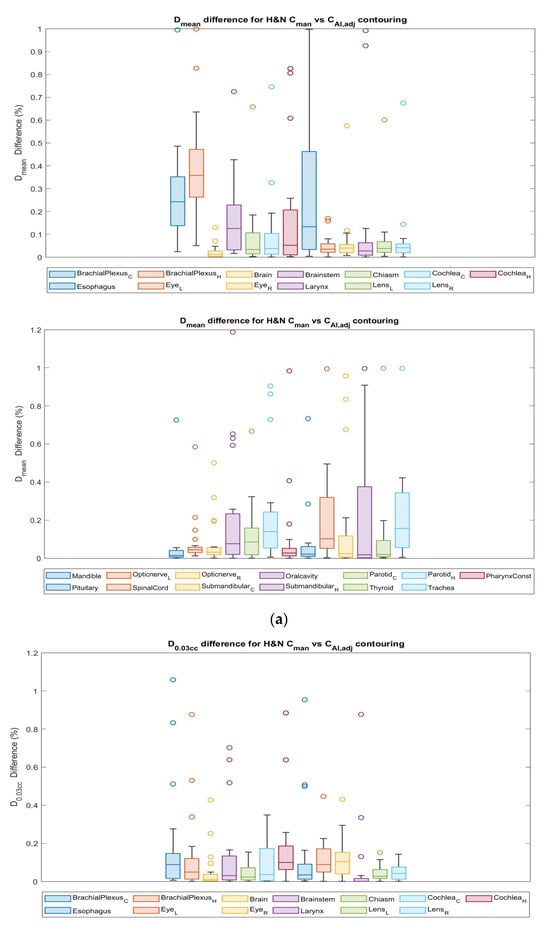
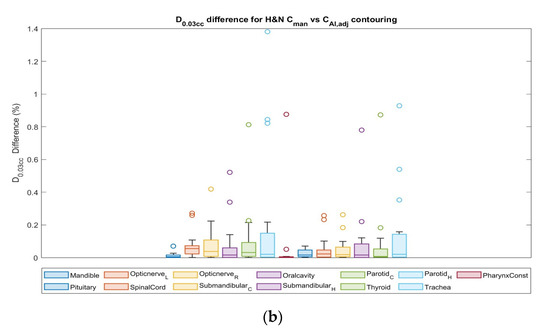
Figure 8.
Dosimetric evaluation results: (a) relative difference in mean dose (Dmean), and (b) relative difference in dose of 0.03cc volume (D0.03cc), for plan form Cman contour in comparison with CAI,adj contours of HNC cases. Each circle symbol represents a value outside the standard deviation.
The dosimetric parameters of the HNC patients are listed in Table 11. The largest differences were seen in both brachial plexuses Dmin and Dmean, with differences up to 82% and 35%, respectively, between the Cman and CAI,adj pairs. The differences were relatively smaller for other OARs between the Cman and CAI,adj contour plan pairs.

Table 11.
Summary of relative differences in Dmin, Dmean, and D0.03cc values for Cman and CAI,adj contours for HNC cases.
Differences between the achieved dosimetric parameters for PCa planning were not significant according to the Wilcoxon test, with the exception of D0.03cc for the anal canal. Brachial plexuses showed significant differences in terms Dmean. The statistical analysis results are shown in Table 12.

Table 12.
Statistical test results for Dmin, Dmean, and D0.03cc values measured between the plans generated from Cman and CAI,adj contours of PCa and HNC cases.
3.5. nPQM Comparison
nPQM revealed that all the plans optimized from CAI,adj were considered equivalent to Cman, with only few plans deemed as inferior to the clinical plan but clinically acceptable. Table 13 summarizes the difference in plan quality for all study sites.

Table 13.
Relative difference in normalized plan quality metric between treatment plans with Cman and CAI,adj contours.
3.6. Time Savings
Table 14 reports the average times required for contouring over all test subjects with different methods in absolute and percentage units of time savings.

Table 14.
Time savings using AI-assisted autocontouring for study sites.
3.7. Interobserver Variability
The qualitative test results showed no significant difference between the two observers. Time saving percentages varied among ROs (from 64% to 72% and 16 to 19 min for PCa, respectively). Only 2% variation was observed in nPQM. A detail geometric differences are shown in Table 15.

Table 15.
Interobserver variability in terms of DSC, HD and RVD values measured between CAI,adj performed by two independent physicians for PCa cases.
As shown in Figure 9, the plans with CAI,adj resulted in anal canal coverage that largely differed from the manual contour plan. No significant geometric differences were found for DSC and RVD by comparison of both RO-reviewed contours with the Cman contour. Table 16 tabulates the difference in dosimetric parameters for observer variability.
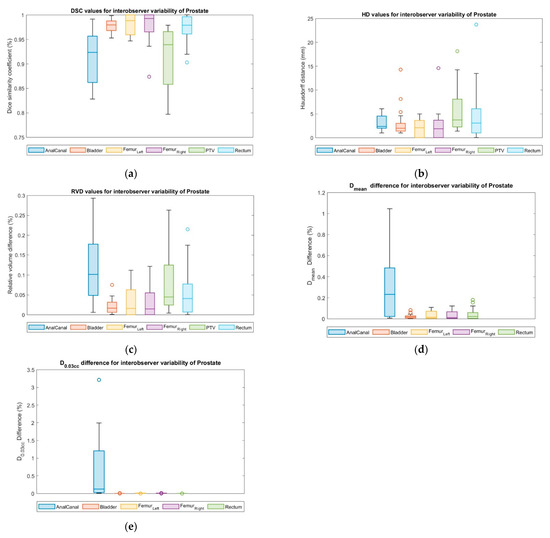
Figure 9.
Geometric evaluation results: (a) DSC, (b) HD in mm, and (c) RVD and dosimetric evaluation results; (d) relative difference in mean dose (Dmean) and (e) relative difference in dose of 0.03cc volume (D0.03cc) of interobserver variability. Each circle symbol represents a value outside the standard deviation.

Table 16.
Summary of relative differences in Dmean and D0.03cc values measured between CAI,adj performed by two different radiation oncologists.
4. Discussion
Since automatic segmentation tools have become a more efficient alternative to expert manual segmentation, it is important that these applications undergo a thorough review, as the full responsibility of the use of AI falls to humans [36]. In particular, the medical physicists have the responsibility of a thorough quality assurance [37] and the radiation oncologist has clinical responsibility of the resulting contours. The purpose of this work was to explore the potential advantages of including an artificial intelligence-based autocontouring system in a clinical pathway in terms of time saving, contour generation accuracy, and radiotherapy plan quality obtained from such reviewed structure sets. The analysis was performed on a dataset of 40 cancer patients equally distributed for PCa and HNC.
As the majority of reported evaluation metrics in the literature are based on geometric metrics [38], and usually evaluate autocontouring without human intervention, we compared both the geometric and dosimetric plan quality performance of the autocontouring software (version: 1.0.18; Limbus AI Inc, Regina, SK, Canada), after physician validation and adjustment, against manual contours.
The first results of this work clearly indicate that with the aid of an AI-based autocontouring system, 72% and 84% of contouring time can be saved for PCa and HNC cases, respectively. More time saving is possible by implementing a fully integrated system that automatically detects the CT image by predefined protocol and contour structures, eliminating manual export/import function. Moreover, the geometric accuracy reached by Limbus AI showed a high compliance with the contours used in the clinical routine. The target and OARs of PCa patients were segmented to high geometric precision, with DSC between Cman and CAI,adj ≥ 0.7. The anal canal contours had the largest differences, with an average value of DSC (0.70) as well as a 30% difference in volume between the Cman and CAI,adj contours.
In comparison to AI-based CAI,adj contours, most of the structures of HNC cases, including the brain, mandible, eyes, and optic nerves, had a high degree of geometric correlation (DSC > 0.98, HD < 3.32 mm, and RVD near to 0). However, there were also structures with low DSC, such as the brachial plexus (DSC = 0.11–0.13), leading to a large variety of results, which is consistent with the previous literature [6,11]. The institutional recommendation to contour a larger larynx, for instance, may result in a poorer geometric correlation of this OAR. Moreover, for this study, the autocontouring software and the oncologist utilized only CT images without contrast enhancement for contouring and revision, while normally, ROs register MRI images to CT images for contouring the OARs.
In principle, the accuracy of contouring has a direct influence on plan optimization, and hence the assessment and decision-making process for treatment plans. As a result, the focus of this study was to determine whether CAI,adj contours could provide equivalent dosimetric findings to Cman contours when examined using dosimetric parameters. The prostate PTV conformity index showed nearly no change in dosimetric analysis; however, there was a 22% difference in HI. Although this study did not contain target volume auto-segmentation, we exclusively examined prostate PTV for observation. The modest dosimetric variation in PTV might be attributed mostly to the expertise and different approach to planning by various medical physicists.
The greatest notable dose difference for PCa OARs’ dose-volume metrics was in the anal canal for the Cman vs. CAI,adj contour plan, whilst other OARs maintained almost the same dose distribution. Femurs indicated slightly higher mean dose, which might be attributed to volume variance in the femur segmentation. In terms of HNC cases, both brachial plexuses showed a greater divergence in the mean dose for the CAI,adj contours as compared to the Cman contours. Otherwise, no significant differences in dose-volume metrics were discovered for those plans. Dosimetric disparities between the Cman and CAI,adj contour plans, on the other hand, were minimal for organs such as the cochlea, parotids, and submandibular glands. Only for the brachial plexus were mean dose differences statistically significant; otherwise, the Wilcoxon rank sum tests failed to identify a significant difference in the achieved dosimetric parameters between these plan pairs, implying that the CAI,adj-generated plans perform similarly to the Cman contour in the dose optimization and evaluation process for HNC planning.
The complex interplay between structure geometry and dose distribution is reflected in the discrepancy between geometric and dosimetric performance. In addition to geometric accuracy, spatial dose distribution and steepness of dose gradients also affect dosimetry performance. Even if there is a significant difference in the dosimetric metrics between the Cman and CAI,adj contours for a structure located far away from the high-dose zone, their absolute dosimetric values may be too small to have an impact on plan assessment and decision making. Furthermore, depending on whether it extracts point or volume-based dosimetry, each dosimetric parameter (i.e., maximum, mean, or volume-based parameter) has a distinct reliance and sensitivity to geometric change. For example, when the size of a structure varies in a high-dose gradient zone, the maximum dose may fluctuate more than the mean dose [4]. Overall, the complex interplay between structure geometry and dose distribution suggests that employing a commercial autosegmentation system that was not trained on local data necessitates further examination that includes both geometric and dosimetric analysis. This critical situation highlights the significance of adopting normalized plan quality metrics as a virtual physician that integrates both geometry and dosimetry assessment. The overall plan quality of PCa and HNC cases with the CAI,adj contour changed by 8.0% and 6.7%, respectively, when compared to the reference plan that was in a relatively acceptable range.
Interobserver variability analysis was conducted for PCa cases, where the geometric and dosimetric data acquired using each of the studied delineations by two ROs and the manual one was analyzed. Time savings and acceptance of AI-driven contours are approximately the same for both ROs. Except for the anal canal contour, there was a good correlation of geometric metrics (DSC > 0.92, HD < 3.74 mm, and RVD < 0.04) between two ROs. There was also a large dose variation (D0.03cc was 12% and Dmean was 23%) for the anal canal, despite the fact that the dose parameters for other OARs were identically matched between ROs. The overall normalized plan quality variation was 2% between ROs, whereas the difference between the Cman and CAI,adj contour plan was 3.2%, suggesting that a standard starting point of contouring can reduce interobserver variability.
We considered manually delineated contours of CRO Aviano as the gold standard in this research. This is not to claim that manual delineation is “better” or “accurate” than AI-based delineation. Experts favored autosegmented contours over manual delineation for specific structures in our ongoing evaluation study. Manual delineation provides a clinically acceptable and recognized contour quality, implying some clinical expertise or local institution practices. As Limbus software (version: 1.0.18; Limbus AI Inc., Regina, SK, Canada) was trained using universal structure sets, software using local institutional datasets can lessen discrepancies because there are always some variances in practice between institutions.
This study has some limitations. Even if the selected cases for each district resulted in a homogeneous dataset, only a subgroup of the patients in this research were evaluated for dosimetry. Although it clearly highlighted the disparity between geometric metrics and dosimetry performance, further research including a wider pool of patient samples will be advantageous in characterizing the dosimetry performance of each unique structure. The contouring was carried out retrospectively using CT images without contrast enhancement and without the registration of MRI and/or PET images, which is now strongly suggested for the contouring of not only treatment volumes, but also OARs in some pathologies. For a more in-depth examination, research registering CT autocontouring with MRI and/or PET images might be a feasible option. To obtain a more complete scenario on how the performance of the Limbus autocontouring system affects the contouring procedure, a comparison with other similar software should be performed. Finally, the 5 mm CT slice thickness in the prostate patients, which is standard practice in our institution, is a relatively large value used in prostates [39]. A change in slice thickness from 5 to 3 mm has been shown to affect only the volume of the bladder significantly [40]. However, this should not affect the main conclusions of the present study, as the slice thickness was always consistent during the comparison among AI and humans in the prostate patients. Despite its limitations, this study offers a proof-of-concept methodology to investigate the impact of including in the RT workflow an autocontouring software.
5. Conclusions
In the contouring process, human assessment is required due to the lack of absolute dependability of automatic segmentation. Nonetheless, providing an approach that has the potential to speed up the contouring process in the vast majority of cases would be an improvement over present clinical practice.
The clinical acceptability and efficacy of the AI-driven approach are dependent on the structural segmentation for the site, and clinical criteria stringency, as demonstrated by the cancer sites. The varying performance of CAI,adj contours across structure sets suggests a different approach, in which automatic segmentation is used to generate a subset of contours where AI consistently performs well, and clinical effort is reserved for the complement subset, which may be more sensitive and subject to significantly larger error or variation.
Dose parameter analysis revealed that treatment plans optimized using AI-generated contours did not result in statistically significant differences when examined using normalized plan quality metrics. The results show that plans based on automatically generated contours do not overdose nearby OARs. However, no statistically significant link between geometric and dosimetric metrics was found. The outcomes from dosimetric analysis and interobserver variability suggest that AI-based autocontouring may help to establish a standard starting point for radiation therapy treatment.
Author Contributions
Conceptualization, S.M.H.H. and P.C.; methodology, S.M.H.H.; software, S.M.H.H. and G.P.; formal analysis, G.P. and M.A.; investigation, A.D. (Alessandra Donofrio) and F.M.; resources, G.F., A.C. and R.B.; writing—original draft preparation, S.M.H.H.; writing—review and editing, A.D. (Annalisa Drigo), R.S.R. and M.A.; supervision, P.C. All authors have read and agreed to the published version of the manuscript.
Funding
This work was supported by the Italian Ministry of Health (Ricerca Corrente) (no grant number provided). The authors would also like to acknowledge the ACC reti 2021—RCR WP12.
Institutional Review Board Statement
The studies involving human participants were reviewed and approved by Comitato Etico Unico Regionale—CEUR Friuli Venezia Giulia, Azienda Regionale di Coordinamento per la Salute (ARCS), via Pozzuolo n. 330—33100 Udine (palazzina B).
Informed Consent Statement
Informed consent was obtained from all subjects involved in the study.
Data Availability Statement
Data available on request due to privacy/ethical restrictions.
Acknowledgments
We are grateful to “Limbus AI Inc.” and “Dosimetrica” for providing a research version of the Limbus AI software.
Conflicts of Interest
The authors declare no conflict of interest.
References
- Barton, M.B.; Jacob, S.; Shafiq, J.; Wong, K.; Thompson, S.R.; Hanna, T.P.; Delaney, G.P. Estimating the demand for radiotherapy from the evidence: A review of changes from 2003 to 2012. Radiother. Oncol. 2014, 112, 140–144. [Google Scholar] [CrossRef]
- Barton, M.B.; Frommer, M.; Shafiq, J. Role of radiotherapy in cancer control in low-income and middle-income countries. Lancet Oncol. 2006, 7, 584–595. [Google Scholar] [CrossRef] [PubMed]
- Cancer Today. Available online: http://gco.iarc.fr/today/home (accessed on 5 November 2022).
- Cao, M.; Stiehl, B.; Yu, V.Y.; Sheng, K.; Kishan, A.U.; Chin, R.K.; Yang, Y.; Ruan, D. Analysis of Geometric Performance and Dosimetric Impact of Using Automatic Contour Segmentation for Radiotherapy Planning. Front. Oncol. 2020, 10, 1762. Available online: https://www.frontiersin.org/articles/10.3389/fonc.2020.01762 (accessed on 30 November 2023). [CrossRef] [PubMed]
- Jameson, M.G.; Holloway, L.C.; Vial, P.J.; Vinod, S.K.; Metcalfe, P.E. A review of methods of analysis in contouring studies for radiation oncology. J. Med. Imaging Radiat. Oncol. 2010, 54, 401–410. [Google Scholar] [CrossRef] [PubMed]
- Kim, N.; Chang, J.S.; Kim, Y.B.; Kim, J.S. Atlas-based auto-segmentation for postoperative radiotherapy planning in endometrial and cervical cancers. Radiat. Oncol. 2020, 15, 106. [Google Scholar] [CrossRef] [PubMed]
- Tong, N.; Gou, S.; Yang, S.; Cao, M.; Sheng, K. Shape constrained fully convolutional DenseNet with adversarial training for multiorgan segmentation on head and neck CT and low-field MR images. Med. Phys. 2019, 46, 2669–2682. [Google Scholar] [CrossRef] [PubMed]
- Jackson, P.; Kron, T.; Hardcastle, N. A future of automated image contouring with machine learning in radiation therapy. J. Med. Radiat. Sci. 2019, 66, 223–225. [Google Scholar] [CrossRef] [PubMed]
- Wong, J.; Huang, V.; Wells, D.; Giambattista, J.; Giambattista, J.; Kolbeck, C.; Otto, K.; Saibishkumar, E.P.; Alexander, A. Implementation of deep learning-based auto-segmentation for radiotherapy planning structures: A workflow study at two cancer centers. Radiat. Oncol. 2021, 16, 101. [Google Scholar] [CrossRef]
- Brouwer, C.L.; Dinkla, A.M.; Vandewinckele, L.; Crijns, W.; Claessens, M.; Verellen, D.; van Elmpt, W. Machine learning applications in radiation oncology: Current use and needs to support clinical implementation. Phys. Imaging Radiat. Oncol. 2020, 16, 144–148. [Google Scholar] [CrossRef]
- Casati, M.; Piffer, S.; Calusi, S.; Marrazzo, L.; Simontacchi, G.; Di Cataldo, V.; Greto, D.; Desideri, I.; Vernaleone, M.; Francolini, G.; et al. Clinical validation of an automatic atlas-based segmentation tool for male pelvis CT images. J. Appl. Clin. Med. Phys. 2022, 23, e13507. [Google Scholar] [CrossRef]
- D’aviero, A.; Re, A.; Catucci, F.; Piccari, D.; Votta, C.; Piro, D.; Piras, A.; Di Dio, C.; Iezzi, M.; Preziosi, F.; et al. Clinical Validation of a Deep-Learning Segmentation Software in Head and Neck: An Early Analysis in a Developing Radiation Oncology Center. Int. J. Environ. Res. Public Health 2022, 19, 9057. [Google Scholar] [CrossRef] [PubMed]
- Zabel, W.J.; Conway, J.L.; Gladwish, A.; Skliarenko, J.; Didiodato, G.; Goorts-Matthews, L.; Michalak, A.; Reistetter, S.; King, J.; Nakonechny, K.; et al. Clinical Evaluation of Deep Learning and Atlas-Based Auto-Contouring of Bladder and Rectum for Prostate Radiation Therapy. Pract. Radiat. Oncol. 2021, 11, e80–e89. [Google Scholar] [CrossRef] [PubMed]
- Taha, A.A.; Hanbury, A. Metrics for evaluating 3D medical image segmentation: Analysis, selection, and tool. BMC Med. Imaging 2015, 15, 29. [Google Scholar] [CrossRef] [PubMed]
- Voet, P.W.; Dirkx, M.L.; Teguh, D.N.; Hoogeman, M.S.; Levendag, P.C.; Heijmen, B.J. Does atlas-based autosegmentation of neck levels require subsequent manual contour editing to avoid risk of severe target underdosage? A dosimetric analysis. Radiother. Oncol. 2011, 98, 373–377. [Google Scholar] [CrossRef] [PubMed]
- Vinod, S.K.; Jameson, M.G.; Min, M.; Holloway, L.C. Uncertainties in volume delineation in radiation oncology: A systematic review and recommendations for future studies. Radiother. Oncol. 2016, 121, 169–179. [Google Scholar] [CrossRef] [PubMed]
- Sharp, G.; Fritscher, K.D.; Pekar, V.; Peroni, M.; Shusharina, N.; Veeraraghavan, H.; Yang, J. Vision 20/20: Perspectives on automated image segmentation for radiotherapy. Med. Phys. 2014, 41, 050902. [Google Scholar] [CrossRef]
- Eclipse|Varian. Available online: https://www.varian.com/products/radiotherapy/treatment-planning/eclipse (accessed on 12 November 2022).
- Offersen, B.V.; Boersma, L.J.; Kirkove, C.; Hol, S.; Aznar, M.C.; Sola, A.B.; Kirova, Y.M.; Pignol, J.-P.; Remouchamps, V.; Verhoeven, K.; et al. ESTRO consensus guideline on target volume delineation for elective radiation therapy of early stage breast cancer. Radiother. Oncol. 2015, 114, 3–10. [Google Scholar] [CrossRef]
- Salembier, C.; Villeirs, G.; De Bari, B.; Hoskin, P.; Pieters, B.R.; Van Vulpen, M.; Khoo, V.; Henry, A.; Bossi, A.; De Meerleer, G.; et al. ESTRO ACROP consensus guideline on CT- and MRI-based target volume delineation for primary radiation therapy of localized prostate cancer. Radiother. Oncol. 2018, 127, 49–61. [Google Scholar] [CrossRef]
- Grégoire, V.; Evans, M.; Le, Q.-T.; Bourhis, J.; Budach, V.; Chen, A.; Eisbruch, A.; Feng, M.; Giralt, J.; Gupta, T.; et al. Delineation of the primary tumour Clinical Target Volumes (CTV-P) in laryngeal, hypopharyngeal, oropharyngeal and oral cavity squamous cell carcinoma: AIRO, CACA, DAHANCA, EORTC, GEORCC, GORTEC, HKNPCSG, HNCIG, IAG-KHT, LPRHHT, NCIC CTG, NCRI, NRG Oncology, PHNS, SBRT, SOMERA, SRO, SSHNO, TROG consensus guidelines. Radiother. Oncol. 2018, 126, 3–24. [Google Scholar] [CrossRef]
- Limbus AI-Automatic Contouring for Radiation Therapy, Limbus AI. Available online: https://limbus.ai/ (accessed on 12 November 2022).
- Wong, J.; Fong, A.; McVicar, N.; Smith, S.; Giambattista, J.; Wells, D.; Kolbeck, C.; Giambattista, J.; Gondara, L.; Alexander, A. Comparing deep learning-based auto-segmentation of organs at risk and clinical target volumes to expert inter-observer variability in radiotherapy planning. Radiother. Oncol. 2020, 144, 152–158. [Google Scholar] [CrossRef]
- Clark, K.; Vendt, B.; Smith, K.; Freymann, J.; Kirby, J.; Koppel, P.; Moore, S.; Phillips, S.; Maffitt, D.; Pringle, M.; et al. The Cancer Imaging Archive (TCIA): Maintaining and Operating a Public Information Repository. J. Digit. Imaging 2013, 26, 1045–1057. [Google Scholar] [CrossRef]
- Avanzo, M.; Pirrone, G.; Vinante, L.; Caroli, A.; Stancanello, J.; Drigo, A.; Massarut, S.; Mileto, M.; Urbani, M.; Trovo, M.; et al. Electron Density and Biologically Effective Dose (BED) Radiomics-Based Machine Learning Models to Predict Late Radiation-Induced Subcutaneous Fibrosis. Front. Oncol. 2020, 10, 490. [Google Scholar] [CrossRef]
- Avanzo, M.; Chiovati, P.; Boz, G.; Sartor, G.; Dozza, F.; Capra, E. Image-guided volumetric arc radiotherapy of pancreatic cancer with simultaneous integrated boost: Optimization strategies and dosimetric results. Phys. Medica 2016, 32, 169–175. [Google Scholar] [CrossRef]
- Baroudi, H.; Brock, K.K.; Cao, W.; Chen, X.; Chung, C.; Court, L.E.; El Basha, M.D.; Farhat, M.; Gay, S.; Gronberg, M.P.; et al. Automated Contouring and Planning in Radiation Therapy: What Is ‘Clinically Acceptable’? Diagnostics 2023, 13, 667. [Google Scholar] [CrossRef]
- Gooding, M.J.; Smith, A.J.; Tariq, M.; Aljabar, P.; Peressutti, D.; van der Stoep, J.; Reymen, B.; Emans, D.; Hattu, D.; van Loon, J.; et al. Comparative evaluation of autocontouring in clinical practice: A practical method using the Turing test. Med. Phys. 2018, 45, 5105–5115. [Google Scholar] [CrossRef]
- Yeghiazaryan, V.; Voiculescu, I. Family of boundary overlap metrics for the evaluation of medical image segmentation. J. Med. Imaging 2018, 5, 015006. [Google Scholar] [CrossRef] [PubMed]
- StructSeg2019-Grand Challenge, Grand-Challenge.org. Available online: https://structseg2019.grand-challenge.org/Evaluation/ (accessed on 30 November 2022).
- Mayo, C.S.; Moran, J.M.; Bosch, W.; Xiao, Y.; McNutt, T.; Popple, R.; Michalski, J.; Feng, M.; Marks, L.B.; Fuller, C.D.; et al. American Association of Physicists in Medicine Task Group 263: Standardizing Nomenclatures in Radiation Oncology. Int. J. Radiat. Oncol. 2017, 100, 1057–1066. [Google Scholar] [CrossRef] [PubMed]
- Doses, A. 3. Special Considerations Regarding Absorbed-Dose and Dose–Volume Prescribing and Reporting in IMRT. J. ICRU 2010, 10, 27–40. [Google Scholar] [CrossRef]
- Feuvret, L.; Noël, G.; Mazeron, J.-J.; Bey, P. Conformity index: A review. Int. J. Radiat. Oncol. 2006, 64, 333–342. [Google Scholar] [CrossRef] [PubMed]
- Nelms, B.E.; Robinson, G.; Markham, J.; Velasco, K.; Boyd, S.; Narayan, S.; Wheeler, J.; Sobczak, M.L. Variation in external beam treatment plan quality: An inter-institutional study of planners and planning systems. Pract. Radiat. Oncol. 2012, 2, 296–305. [Google Scholar] [CrossRef] [PubMed]
- MATLAB-MathWorks. Available online: https://ww2.mathworks.cn/en/products/matlab.html (accessed on 30 November 2022).
- Avanzo, M.; Trianni, A.; Botta, F.; Talamonti, C.; Stasi, M.; Iori, M. Artificial Intelligence and the Medical Physicist: Welcome to the Machine. Appl. Sci. 2021, 11, 1691. [Google Scholar] [CrossRef]
- Zanca, F.; Brusasco, C.; Pesapane, F.; Kwade, Z.; Beckers, R.; Avanzo, M. Regulatory Aspects of the Use of Artificial Intelligence Medical Software. Semin. Radiat. Oncol. 2022, 32, 432–441. [Google Scholar] [CrossRef] [PubMed]
- Mackay, K.; Bernstein, D.; Glocker, B.; Kamnitsas, K.; Taylor, A. A Review of the Metrics Used to Assess Auto-Contouring Systems in Radiotherapy. Clin. Oncol. 2023, 35, 354–369. [Google Scholar] [CrossRef] [PubMed]
- Kim, Y.; Hsu, I.J.; Lessard, E.; Pouliot, J.; Vujic, J. Dose uncertainty due to computed tomography (CT) slice thickness in CT-based high dose rate brachytherapy of the prostate cancer. Med. Phys. 2004, 31, 2543–2548. [Google Scholar] [CrossRef] [PubMed]
- Berthelet, E.; Liu, M.; Truong, P.; Czaykowski, P.; Kalach, N.; Yu, C.; Patterson, K.; Currie, T.; Kristensen, S.; Kwan, W.; et al. CT slice index and thickness: Impact on organ contouring in radiation treatment planning for prostate cancer. J. Appl. Clin. Med. Phys. 2003, 4, 365–373. [Google Scholar] [CrossRef]
Disclaimer/Publisher’s Note: The statements, opinions and data contained in all publications are solely those of the individual author(s) and contributor(s) and not of MDPI and/or the editor(s). MDPI and/or the editor(s) disclaim responsibility for any injury to people or property resulting from any ideas, methods, instructions or products referred to in the content. |
© 2023 by the authors. Licensee MDPI, Basel, Switzerland. This article is an open access article distributed under the terms and conditions of the Creative Commons Attribution (CC BY) license (https://creativecommons.org/licenses/by/4.0/).